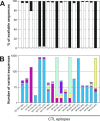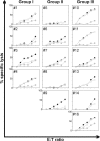Cross-recognition of avian H5N1 influenza virus by human cytotoxic T-lymphocyte populations directed to human influenza A virus
- PMID: 18353950
- PMCID: PMC2395172
- DOI: 10.1128/JVI.02694-07
Cross-recognition of avian H5N1 influenza virus by human cytotoxic T-lymphocyte populations directed to human influenza A virus
Abstract
Since the number of human cases of infection with avian H5N1 influenza viruses is ever increasing, a pandemic outbreak caused by these viruses is feared. Therefore, in addition to virus-specific antibodies, there is considerable interest in immune correlates of protection against these viruses, which could be a target for the development of more universal vaccines. After infection with seasonal influenza A viruses of the H3N2 and H1N1 subtypes, individuals develop virus-specific cytotoxic T-lymphocyte responses, which are mainly directed against the relatively conserved internal proteins of the virus, like the nucleoprotein (NP). Virus-specific cytotoxic T lymphocytes (CTL) are known to contribute to protective immunity against infection, but knowledge about the extent of cross-reactivity with avian H5N1 influenza viruses is sparse. In the present study, we evaluated the cross-reactivity with H5N1 influenza viruses of polyclonal CTL obtained from a group of well-defined HLA-typed study subjects. To this end, the recognition of synthetic peptides representing H5N1 analogues of known CTL epitopes was studied. In addition, the ability of CTL specific for seasonal H3N2 influenza virus to recognize the NP of H5N1 influenza virus or H5N1 virus-infected cells was tested. It was concluded that, apart from some individual epitopes that displayed amino acid variation between H3N2 and H5N1 influenza viruses, considerable cross-reactivity exists with H5N1 viruses. This preexisting cross-reactive T-cell immunity in the human population may dampen the impact of a next pandemic.
Figures




Similar articles
-
Infection of mice with a human influenza A/H3N2 virus induces protective immunity against lethal infection with influenza A/H5N1 virus.Vaccine. 2009 Aug 6;27(36):4983-9. doi: 10.1016/j.vaccine.2009.05.079. Epub 2009 Jun 16. Vaccine. 2009. PMID: 19538996
-
A CTL-based liposomal vaccine capable of inducing protection against heterosubtypic influenza viruses in HLA-A*0201 transgenic mice.Biochem Biophys Res Commun. 2010 Jan 15;391(3):1494-9. doi: 10.1016/j.bbrc.2009.12.100. Biochem Biophys Res Commun. 2010. PMID: 20060099
-
Human cytotoxic T lymphocytes directed to seasonal influenza A viruses cross-react with the newly emerging H7N9 virus.J Virol. 2014 Feb;88(3):1684-93. doi: 10.1128/JVI.02843-13. Epub 2013 Nov 20. J Virol. 2014. PMID: 24257602 Free PMC article.
-
Influenza virus-specific cytotoxic T lymphocytes: a correlate of protection and a basis for vaccine development.Curr Opin Biotechnol. 2007 Dec;18(6):529-36. doi: 10.1016/j.copbio.2007.11.002. Curr Opin Biotechnol. 2007. PMID: 18083548 Review.
-
Immune responses to infection with H5N1 influenza virus.Virus Res. 2013 Dec 5;178(1):44-52. doi: 10.1016/j.virusres.2013.05.011. Epub 2013 Jun 2. Virus Res. 2013. PMID: 23735534 Free PMC article. Review.
Cited by
-
Increase in IFNγ(-)IL-2(+) cells in recent human CD4 T cell responses to 2009 pandemic H1N1 influenza.PLoS One. 2013;8(3):e57275. doi: 10.1371/journal.pone.0057275. Epub 2013 Mar 20. PLoS One. 2013. PMID: 23526940 Free PMC article.
-
Expression of H3N2 nucleoprotein in maize seeds and immunogenicity in mice.Plant Cell Rep. 2015 Jun;34(6):969-80. doi: 10.1007/s00299-015-1758-0. Epub 2015 Feb 13. Plant Cell Rep. 2015. PMID: 25677970
-
A single dose of DNA vaccine based on conserved H5N1 subtype proteins provides protection against lethal H5N1 challenge in mice pre-exposed to H1N1 influenza virus.Virol J. 2010 Aug 21;7:197. doi: 10.1186/1743-422X-7-197. Virol J. 2010. PMID: 20727202 Free PMC article.
-
Profiling the TRB and IGH repertoire of patients with H5N6 Avian Influenza Virus Infection by high-throughput sequencing.Sci Rep. 2019 May 15;9(1):7429. doi: 10.1038/s41598-019-43648-y. Sci Rep. 2019. PMID: 31092835 Free PMC article.
-
Development of adenoviral vector-based mucosal vaccine against influenza.J Mol Med (Berl). 2011 Apr;89(4):331-41. doi: 10.1007/s00109-010-0696-0. Epub 2010 Nov 21. J Mol Med (Berl). 2011. PMID: 21104066 Review.
References
-
- Claas, E. C., A. D. Osterhaus, R. van Beek, J. C. De Jong, G. F. Rimmelzwaan, D. A. Senne, S. Krauss, K. F. Shortridge, and R. G. Webster. 1998. Human influenza A H5N1 virus related to a highly pathogenic avian influenza virus. Lancet 351472-477. - PubMed
-
- Epstein, S. L. 2006. Prior H1N1 influenza infection and susceptibility of Cleveland Family Study participants during the H2N2 pandemic of 1957: an experiment of nature. J. Infect. Dis. 19349-53. - PubMed
-
- Fleischer, B., H. Becht, and R. Rott. 1985. Recognition of viral antigens by human influenza A virus-specific T lymphocyte clones. J. Immunol. 1352800-2804. - PubMed
Publication types
MeSH terms
Substances
LinkOut - more resources
Full Text Sources
Other Literature Sources
Medical
Molecular Biology Databases
Research Materials
Miscellaneous

